Deformation Behavior of Transient Liquid-Phase Sintered Cu-Solder-Resin Microstructure for Die-Attach
Abstract
:1. Introduction
2. Experimental Method
3. Finite Element Analysis
3.1. Modeling of the Cu-IMC-Resin Microstructure Based on 3D Image Reconstruction
3.2. SiC-DBC Model Based on Homogenized Properties of Cu-IMC-Resin
4. Results and Discussion
4.1. Characterization of Macro-Deformation Behavior
4.2. Reliability of TLPS Joints during Thermal Cycling
4.3. Impact of the Macro- and Micro-Deformation Behavior on the Thermal Cycling Reliability
5. Conclusions
Author Contributions
Funding
Acknowledgments
Conflicts of Interest
References
- Manikam, V.R.; Cheong, K.Y. Die attach materials for high temperature applications: A review. IEEE Trans. Compon. Packag. Manuf. Technol. 2011, 1, 457–478. [Google Scholar] [CrossRef]
- Kisiel, R.; Szczepański, Z. Die-attachment solutions for SiC power devices. Microelectron. Reliab. 2009, 49, 627–629. [Google Scholar] [CrossRef]
- Ide, E.; Angata, S.; Hirose, A.; Kobayashi, K.F. Metal-metal bonding process using Ag metallo-organic nanoparticles. Acta Mater. 2005, 53, 2385–2393. [Google Scholar] [CrossRef]
- Akada, Y.; Tatsumi, H.; Yamaguchi, T.; Hirose, A.; Morita, T.; Ide, E. Interfacial Bonding Mechanism Using Silver Metallo-Organic Nanoparticles to Bulk Metals and Observation of Sintering Behavior. Mater. Trans. 2008, 49, 1537–1545. [Google Scholar] [CrossRef] [Green Version]
- Ogura, T.; Nishimura, M.; Tatsumi, H.; Takahara, W.; Hirose, A. Interfacial Bonding Behavior between Silver Nanoparticles and Gold Substrate Using Molecular Dynamics Simulation. Mater. Trans. 2012, 53, 2085–2090. [Google Scholar] [CrossRef] [Green Version]
- Tatsumi, H.; Kumada, S.; Fukuda, A.; Yamaguchi, H.; Kashiba, Y. Impact of Metallurgical and Mechanical Properties of Sintered Silver Nanoparticles on Die-attach Reliability of High-temperature Power Modules. J. Microelectron. Electron. Packag. 2016, 13, 121–127. [Google Scholar] [CrossRef]
- Bai, J.G.; Zhang, Z.Z.; Calata, J.N.; Lu, G.Q. Low-temperature sintered nanoscale silver as a novel semiconductor device-metallized substrate interconnect material. IEEE Trans. Compon. Packag. Technol. 2006, 29, 589–593. [Google Scholar] [CrossRef]
- Alarifi, H.; Hu, A.; Yavuz, M.; Zhou, Y.N. Silver nanoparticle paste for low-temperature bonding of copper. J. Electron. Mater. 2011, 40, 1394–1402. [Google Scholar] [CrossRef]
- Sakamoto, S.; Sugahara, T.; Suganuma, K. Microstructural stability of Ag sinter joining in thermal cycling. J. Mater. Sci. Mater. Electron. 2013, 24, 1332–1340. [Google Scholar] [CrossRef]
- Zheng, H.; Berry, D.; Ngo, K.D.T.; Lu, G.Q. Chip-bonding on copper by pressureless sintering of nanosilver paste under controlled atmosphere. IEEE Trans. Compon. Packag. Manuf. Technol. 2014, 4, 377–384. [Google Scholar] [CrossRef]
- Fu, S.; Mei, Y.; Lu, G.Q.; Li, X.; Chen, G.; Chen, X. Pressureless sintering of nanosilver paste at low temperature to join large area (≥100 mm2) power chips for electronic packaging. Mater. Lett. 2014, 128, 42–45. [Google Scholar] [CrossRef]
- Wang, S.; Li, M.; Ji, H.; Wang, C. Rapid pressureless low-temperature sintering of Ag nanoparticles for high-power density electronic packaging. Scr. Mater. 2013, 69, 789–792. [Google Scholar] [CrossRef]
- Chua, S.T.; Siow, K.S. Microstructural studies and bonding strength of pressureless sintered nano-silver joints on silver, direct bond copper (DBC) and copper substrates aged at 300 °C. J. Alloys Compd. 2016, 687, 486–498. [Google Scholar] [CrossRef]
- Kähler, J.; Heuck, N.; Wagner, A.; Stranz, A.; Peiner, E.; Waag, A. Sintering of copper particles for die attach. IEEE Trans. Compon. Packag. Manuf. Technol. 2012, 2, 1587–1591. [Google Scholar] [CrossRef]
- Yoon, J.-W.; Back, J.-H. Effect of Sintering Conditions on the Mechanical Strength of Cu-Sintered Joints for High-Power Applications. Materials 2018, 11, 2105. [Google Scholar] [CrossRef] [PubMed]
- Gao, R.; He, S.; Shen, Y.A.; Nishikawa, H. Effect of Substrates on Fracture Mechanism and Process Optimization of Oxidation–Reduction Bonding with Copper Microparticles. J. Electron. Mater. 2019, 48, 2263–2271. [Google Scholar] [CrossRef]
- Greve, H.; Chen, L.Y.; Fox, I.; McCluskey, F.P. Transient liquid phase sintered attach for power electronics. In Proceedings of the 2013 IEEE 63rd Electronic Components and Technology Conference (ECTC), Las Vegas, NV, USA, 28–31 May 2013; pp. 435–440. [Google Scholar]
- Lee, B.S.; Yoon, J.W. Cu-Sn Intermetallic Compound Joints for High-Temperature Power Electronics Applications. J. Electron. Mater. 2018, 47, 430–435. [Google Scholar] [CrossRef]
- Mokhtari, O.; Nishikawa, H. Transient liquid phase bonding of Sn–Bi solder with added Cu particles. J. Mater. Sci. Mater. Electron. 2016, 27, 4232–4244. [Google Scholar] [CrossRef]
- Liu, X.; He, S.; Nishikawa, H. Low temperature solid-state bonding using Sn-coated Cu particles for high temperature die attach. J. Alloys Compd. 2017, 695, 2165–2172. [Google Scholar] [CrossRef]
- Hu, T.; Chen, H.; Li, M.; Zhao, Z. Cu@Sn Core—Shell Structure Powder Preform for High-Temperature Applications Based on Transient Liquid Phase Bonding. IEEE Trans. Power Electron. 2016, 32, 441–451. [Google Scholar]
- Yoon, S.W.; Glover, M.D.; Shiozaki, K. Nickel-tin transient liquid phase bonding toward high-temperature operational power electronics in electrified vehicles. IEEE Trans. Power Electron. 2013, 28, 2448–2456. [Google Scholar] [CrossRef]
- Feng, H.; Huang, J.; Yang, J.; Zhou, S.; Zhang, R.; Chen, S. A Transient Liquid Phase Sintering Bonding Process Using Nickel-Tin Mixed Powder for the New Generation of High-Temperature Power Devices. J. Electron. Mater. 2017, 46, 4152–4159. [Google Scholar] [CrossRef]
- Fujino, M.; Narusawa, H.; Kuramochi, Y.; Higurashi, E.; Suga, T.; Shiratori, T.; Mizukoshi, M. Transient liquid-phase sintering using silver and tin powder mixture for die bonding. Jpn. J. Appl. Phys. 2016, 55, 04EC14. [Google Scholar] [CrossRef]
- Guth, K.; Heuck, N.; Stahlhut, C.; Ciliox, A.; Oeschler, N.; Ag, I.T. End-of-life investigation on the XT interconnect technology. In Proceedings of the PCIM Europe 2015, Nuremberg, Germany, 19–21 May 2015; pp. 72–79. [Google Scholar]
- Guth, K.; Oeschler, N.; Böwer, L.; Speckels, R.; Strotmann, G.; Heuck, N.; Krasel, S.; Ciliox, A. New assembly and interconnect technologies for power modules. In Proceedings of the Integrated Power Electronics Systems (CIPS) 2012 7th International Conference, Nuremberg, Germany, 6–8 March 2012; pp. 1–5. [Google Scholar]
- Dudek, R.; Sommer, P.; Fix, A.; Rzepka, S.; Michel, B. Reliability issues for high temperature interconnections based on transient liquid phase soldering. In Proceedings of the 14th International Conference on Thermal, Mechanical and Multi-Physics Simulation and Experiments in Microelectronics and Microsystems (EuroSimE), Wroclaw, Poland, 14–17 April 2013; pp. 1–8. [Google Scholar]
- Lee, B.S.; Hyun, S.K.; Yoon, J.W. Cu–Sn and Ni–Sn transient liquid phase bonding for die-attach technology applications in high-temperature power electronics packaging. J. Mater. Sci. Mater. Electron. 2017, 28, 7827–7833. [Google Scholar] [CrossRef]
- Greve, H.; Moeini, S.A.; McCluskey, P.; Joshi, S. Prediction and Mitigation of Vertical Cracking in High-Temperature Transient Liquid Phase Sintered Joints by Thermo-Mechanical Simulation. J. Electron. Packag. 2018, 140, 020903. [Google Scholar] [CrossRef]
- Shearer, C.; Shearer, B.; Matijasevic, G.; Gandhi, P. Transient liquid phase sintering composites: Polymer adhesives with metallurgical bonds. J. Electron. Mater. 1999, 28, 1319–1326. [Google Scholar] [CrossRef]
- Gallagher, C.; Matijasevic, G.; Maguire, J.F. Transient Liquid Phase Sintering Conductive Adhesives. In Proceedings of the 1997 IEEE 47th Electronic Components and Technology Conference (ECTC), San Jose, CA, USA, 18–21 May 1997; pp. 554–560. [Google Scholar]
- Zhang, Z.; Wong, C.P. Recent advances in flip-chip underfill: Materials, process, and reliability. IEEE Trans. Adv. Packag. 2004, 27, 515–524. [Google Scholar] [CrossRef]
- Tatsumi, H.; Lis, A.; Yamaguchi, H.; Kashiba, Y.; Hirose, A. Evaluation of Stiffness-Reduced Joints by Transient Liquid-Phase Sintering of Copper-Solder-Resin Composite for SiC Die-Attach Applications. IEEE Trans. Compon. Packag. Manuf. Technol. 2019. [Google Scholar] [CrossRef]
- Tatsumi, H.; Lis, A.; Yamaguchi, H.; Matsuda, T.; Sano, T.; Kashiba, Y.; Hirose, A. Evolution of Transient Liquid-Phase Sintered Cu-Sn Skeleton Microstructure During Thermal Aging. Appl. Sci. 2019, 9, 157. [Google Scholar] [CrossRef]
- Ansys, Inc. ANSYS 18.2 Workbench User’s Guide; Ansys, Inc.: Canonsburg, PA, USA, 2017. [Google Scholar]
- Forquin, P.; Denoual, C.; Cottenot, C.E.; Hild, F. Experiments and modelling of the compressive behaviour of two SiC ceramics. Mech. Mater. 2003, 35, 987–1002. [Google Scholar] [CrossRef] [Green Version]
- Chen, C.; Choe, C.; Zhang, Z.; Kim, D.; Suganuma, K. Low-stress design of bonding structure and its thermal shock performance (−50 to 250 °C) in SiC/DBC power die-attached modules. J. Mater. Sci. Mater. Electron. 2018, 29, 14335–14346. [Google Scholar] [CrossRef]
- Jenkins, W.D.; Digges, T.G.; Johnson, C.R. Tensile properties of copper, nickel, and 70% copper 30% nickel and 30% copper 70% nickel alloys at high temperatures. J. Res. Natl. Bur. Stand. 1957, 58, 201–211. [Google Scholar] [CrossRef]
- Deng, X.; Chawla, N.; Chawla, K.K.; Koopman, M. Deformation behavior of (Cu, Ag)-Sn intermetallics by nanoindentation. Acta Mater. 2004, 52, 4291–4303. [Google Scholar] [CrossRef]
- Shohji, I.; Yoshida, T.; Takahashi, T.; Hioki, S. Tensile Properties of Sn-3. 5Ag and Sn-3. 5Ag-0. 75Cu Lead-free Solders. Mater. Trans. 2002, 43, 1854–1857. [Google Scholar] [CrossRef]
- Lall, P.; Shantaram, S.; Suhling, J.; Locker, D. Effect of aging on the high strain rate mechanical properties of SAC105 and SAC305 leadfree alloys. In Proceedings of the 2013 IEEE 63rd Electronic Components and Technology Conference (ECTC), Las Vegas, NV, USA, 28–31 May 2013; pp. 1277–1293. [Google Scholar]
- Liu, L.; Chen, Z.; Liu, C.; Wu, Y.; An, B. Micro-mechanical and fracture characteristics of Cu6Sn5 and Cu3Sn intermetallic compounds under micro-cantilever bending. Intermetallics 2016, 76, 10–17. [Google Scholar] [CrossRef]
- Lis, A.; Kicin, S.; Brem, F.; Leinenbach, C. Thermal Stress Assessment for Transient Liquid-Phase Bonded Si Chips in High-Power Modules Using Experimental and Numerical Methods. J. Electron. Mater. 2017, 46, 729–741. [Google Scholar] [CrossRef]
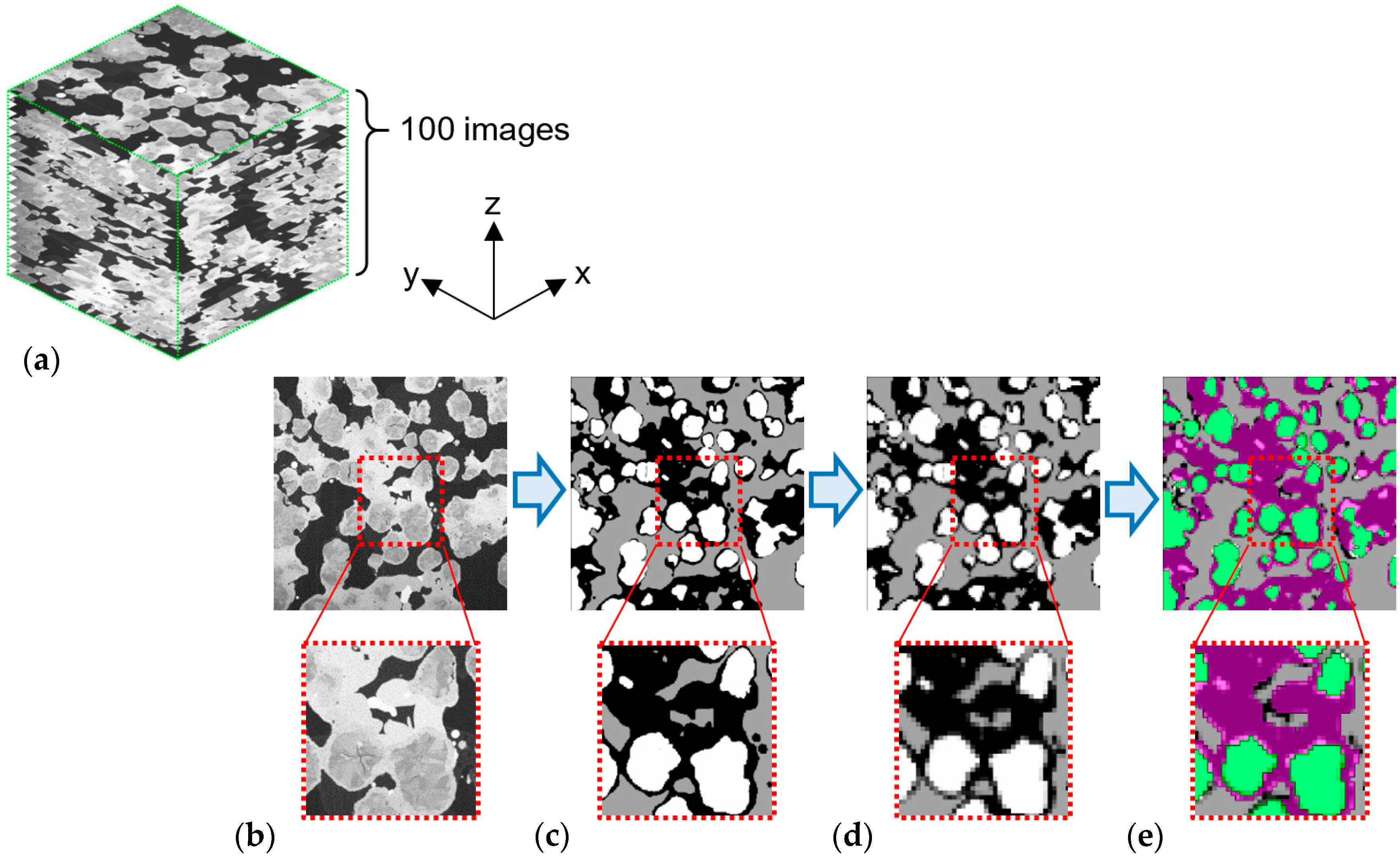
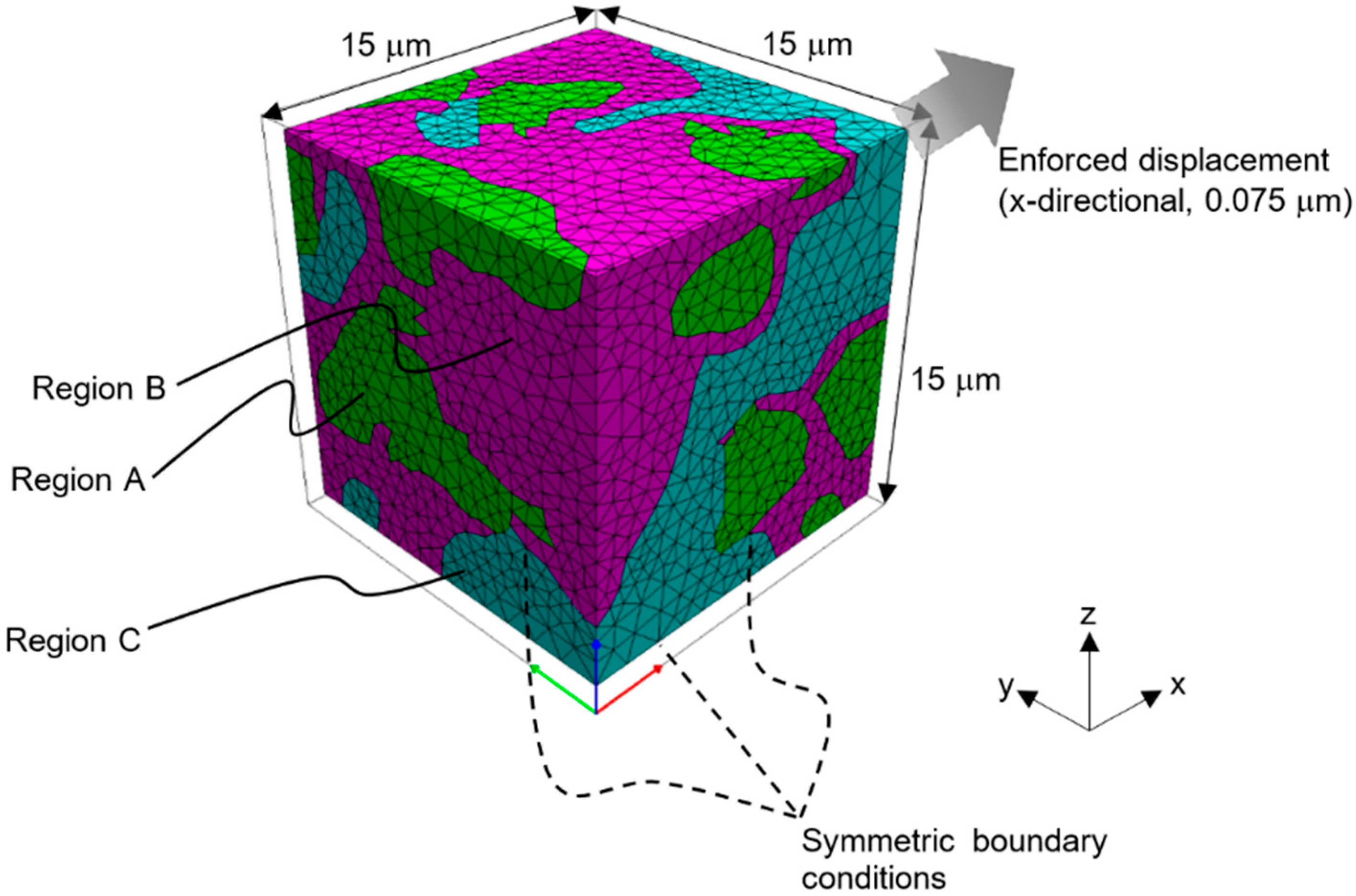
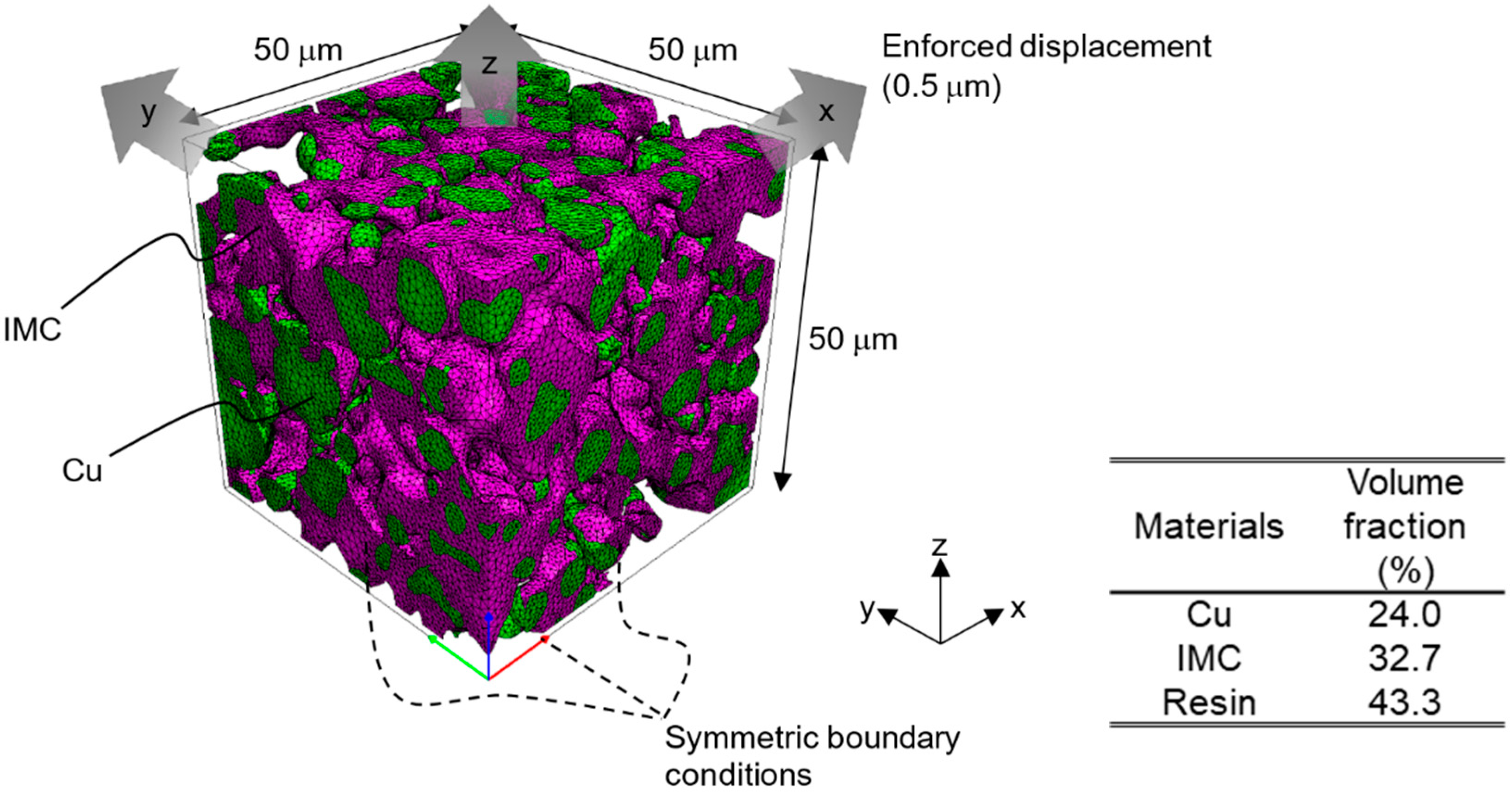

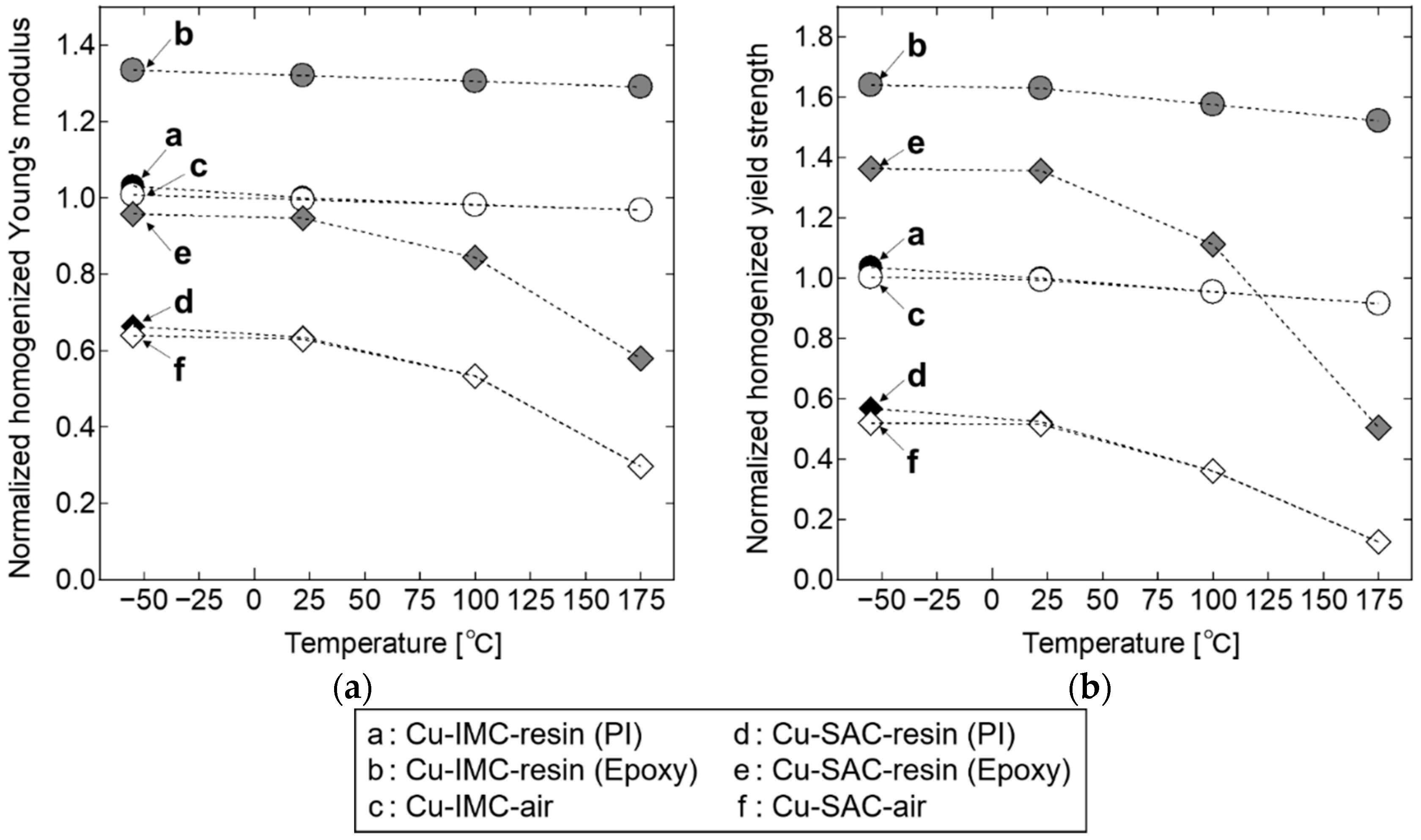
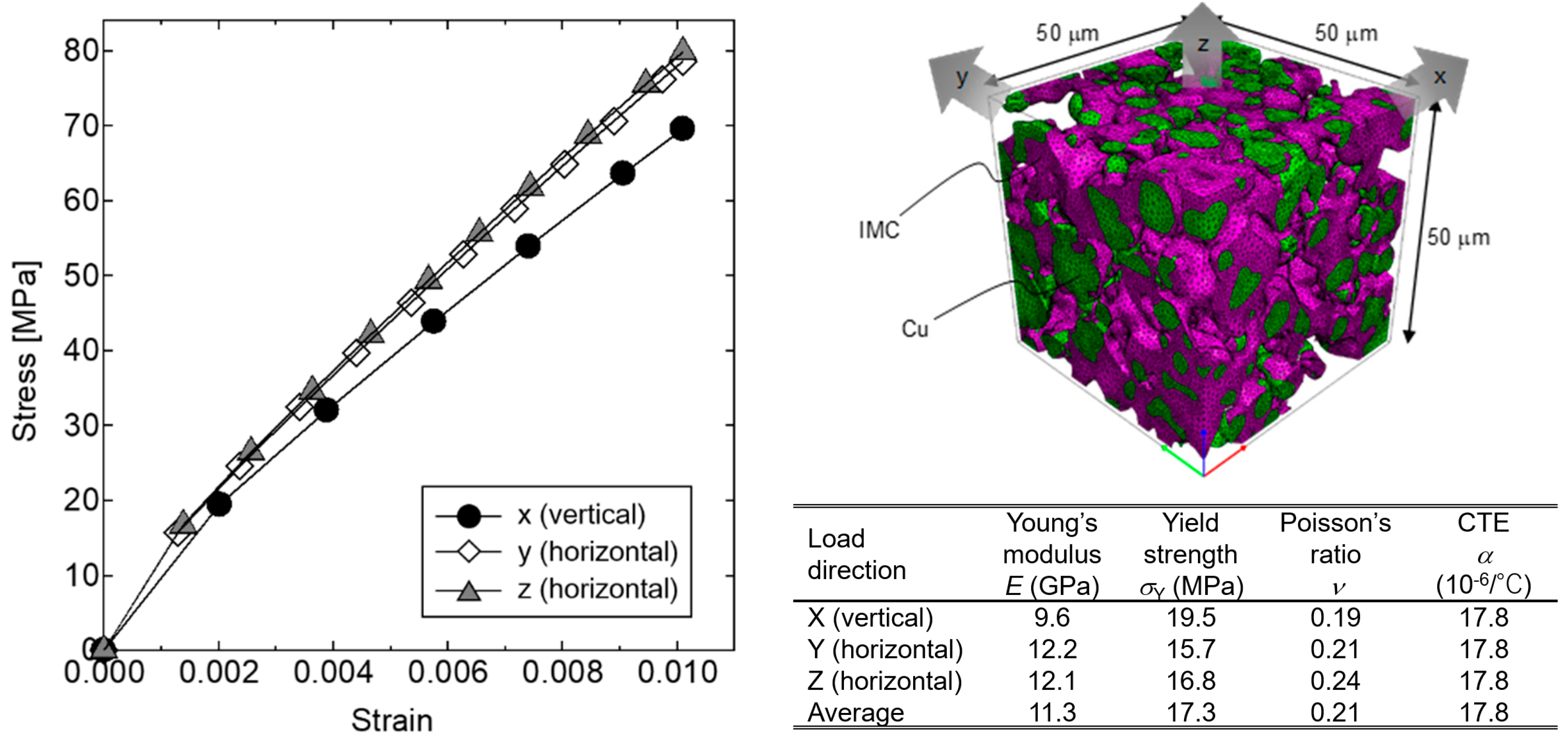




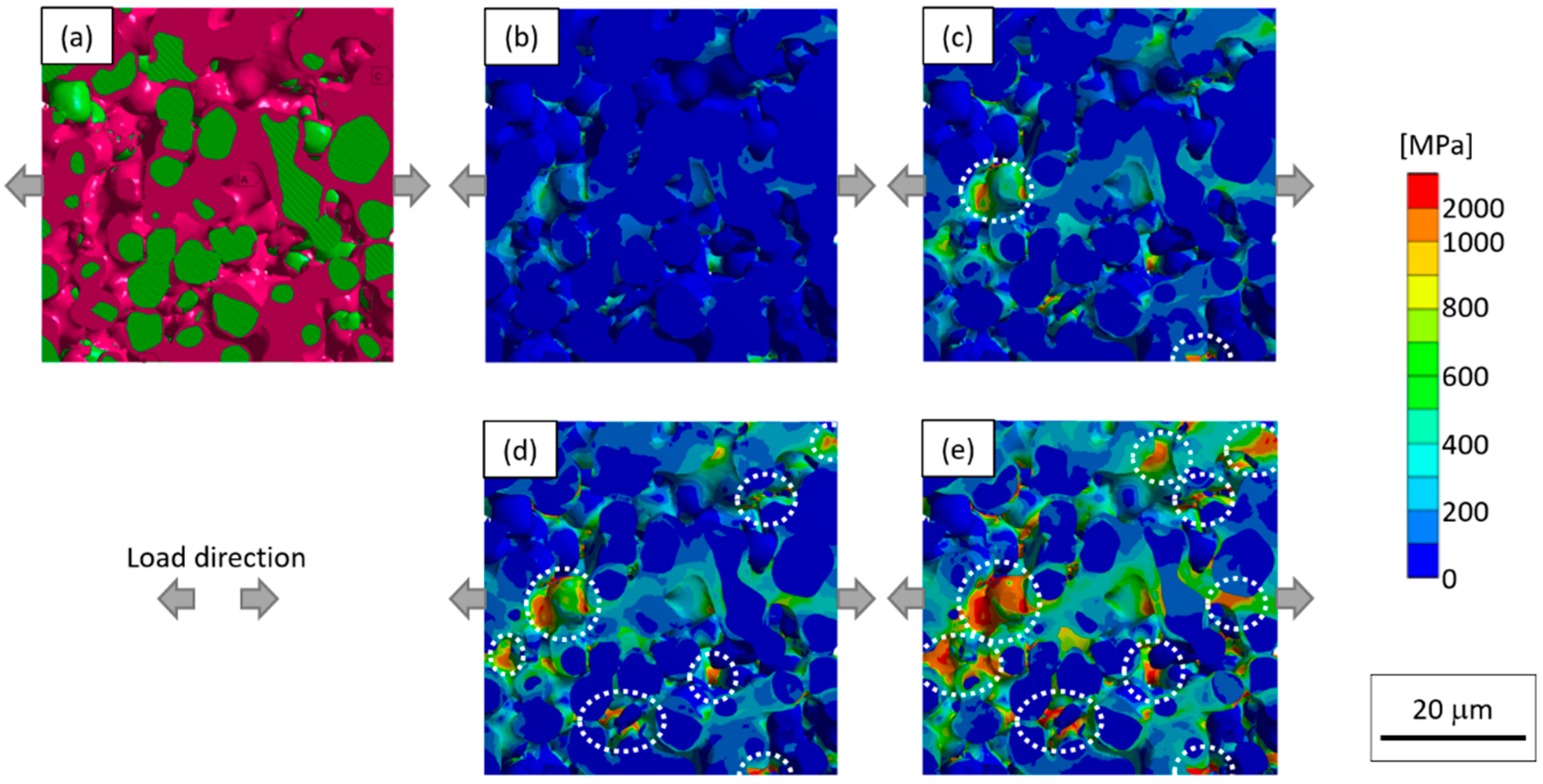
| Case | Regions | ||
|---|---|---|---|
| A | B | C | |
| Cu-IMC-resin (PI) | Cu | IMC (Cu6Sn5) | Polyimide-resin |
| Cu-IMC-resin (Epoxy) | Cu | IMC (Cu6Sn5) | Epoxy-resin |
| Cu-IMC-air | Cu | IMC (Cu6Sn5) | Air |
| Cu-SAC-resin (PI) | Cu | SAC305 | Polyimide-resin |
| Cu-SAC-resin (Epoxy) | Cu | SAC305 | Epoxy-resin |
| Cu-SAC-air | Cu | SAC305 | Air |
| Material | Young’s Modulus E (GPa) | Yield Strength σY (MPa) | Ultimate Tensile Strength σUTS (MPa) | CTE α (10−6/°C) | Poisson’s Ratio ν |
|---|---|---|---|---|---|
| SiC | 410 | -- | -- | 3.8 | 0.33 |
| Si3N4 | 314 | -- | -- | 3.0 | 0.33 |
| Cu | 96 (0 °C) | 52 (0 °C) | 240 (0 °C) | 16.7 | 0.33 |
| 88 (300 °C) | 42 (300 °C) | 178 (300 °C) | |||
| IMC (Cu6Sn5) | 102 | -- | -- | 18.3 | 0.31 |
| SAC305 | 46 (RT) | 45 (RT) | 58 (RT) | 21.2 (RT) | 0.36 |
| 35 (100 °C) | 15 (125 °C) | 23 (125 °C) | 22.0 (100 °C) | ||
| 4 (200 °C) | 3 (200 °C) | 4 (200 °C) | 22.5 (200 °C) |
| Type of Resin | Young’s Modulus E (GPa) | Yield Strength σY (MPa) | Ultimate Tensile Strength σUTS (MPa) | CTE α (10−6/°C) | Poisson’s Ratio ν |
|---|---|---|---|---|---|
| Polyimide-resin, used in this study | 0.120 (−40 °C) | 4.0 (−40 °C) | 16.4 (−40 °C) | 38.0 | 0.37 |
| 0.021 (RT) | 1.0 (RT) | 4.0 (RT °C) | |||
| 0.004 (100 °C) | 0.2 (100 °C) | 0.7 (100 °C) | |||
| 0.001 (150 °C) | 0.1 (150 °C) | 0.2 (150 °C) | |||
| Epoxy-resin | 2.0 | 30 | 70 | 38.0 | 0.37 |
© 2019 by the authors. Licensee MDPI, Basel, Switzerland. This article is an open access article distributed under the terms and conditions of the Creative Commons Attribution (CC BY) license (http://creativecommons.org/licenses/by/4.0/).
Share and Cite
Tatsumi, H.; Yamaguchi, H.; Matsuda, T.; Sano, T.; Kashiba, Y.; Hirose, A. Deformation Behavior of Transient Liquid-Phase Sintered Cu-Solder-Resin Microstructure for Die-Attach. Appl. Sci. 2019, 9, 3476. https://doi.org/10.3390/app9173476
Tatsumi H, Yamaguchi H, Matsuda T, Sano T, Kashiba Y, Hirose A. Deformation Behavior of Transient Liquid-Phase Sintered Cu-Solder-Resin Microstructure for Die-Attach. Applied Sciences. 2019; 9(17):3476. https://doi.org/10.3390/app9173476
Chicago/Turabian StyleTatsumi, Hiroaki, Hiroshi Yamaguchi, Tomoki Matsuda, Tomokazu Sano, Yoshihiro Kashiba, and Akio Hirose. 2019. "Deformation Behavior of Transient Liquid-Phase Sintered Cu-Solder-Resin Microstructure for Die-Attach" Applied Sciences 9, no. 17: 3476. https://doi.org/10.3390/app9173476






